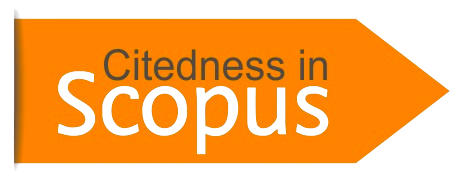Media Stamp Game untuk Meningkatkan Kemampuan Berhitung Anak Slow Learner di Sekolah Dasar
DOI:
https://doi.org/10.15575/psy.v5i2.2977Keywords:
stamp game media, the ability to counting, slow learnerAbstract
Slow learner children may find it hard to learn abstract and symbolic concepts, which could lead to difficulties in math learning, such as sum. The stamp game is a learning media with a concept to teach count operation (sum) with concrete form that is easy to use by children with simple steps and used repeatedly to reinforce the concepts. Thus, it may improve math ability in slow learner children. The purpose of this study is to improve the ability of counting operations (sum) in elementary school students who are slow learner by using the stamp game. This study used single case experimental design. The participants were three slow learner children selected using purposive sampling technique. The results of the research show that the stamp game can improve counting (sum) ability in elementary school students who are a slow learner.
References
Abdurrahman, M. (2003). Pendidikan bagi anak berkesulitan belajar. Jakarta: PT. Rineka Cipta.
Adhalia, D. & Gunanto. (2016). ESPS (erlangga straight point series) matematika untuk SD/MI kelas II. Jakarta: Erlangga.
Arikunto, S. (2007). Dasar-dasar evaluasi pendidikan. Jakarta: Bumi Aksara.
Ariyanti, & Muslimin, Z. I. (2015) Efektivitas alat permainan edukatif (APE) berbasis media dalam meningkatkan kemampuan berhitung pada anak kelas 2 di SDN 2 Wonotirto Bulu Temanggung. Jurnal Psikologi Tabularasa, 10(1), 58–69.
Arnidha, Y. (2015). Analisis kesalahan siswa dalam menyelesaikan soal operasi hitung bilangan cacah. Journal e-DuMath, 1(1), 52–63.
Aziz, A. N, Sugirman, & Prabowo, A. (2015). Analisis proses pembelajaran matematika pada anak berkebutuhan khusus (ABK) slow learner di kelas inklusif SMP Negeri 7 Salatiga. Jurnal Matematika Kreatif-Inovatif, 6(2), 111–120.
Chauhan, S. (2011). Slow learners: Their psychology and educational programmes. International journal of multidisciplinary research, 1(8), 279–289.
Dasaradhi, K., Rajeswari, S. R., & Badarinath, P. (2016). 30 methods to improve learning capability in slow learners. International Journal of English Language, Literature and Humanities, 4(2), 556–570.
Desiningrum, D. R. (2016). Psikologi anak berkebutuhan khusus. Yogyakarta: Psikosain.
Frengky. (2008). Model pembelajaran matematika siswa kelas satu sekolah dasar. Jurnal Psikologi, 35(2), 151–163.
Garnida, D. (2015). Pengantar pendidikan inklusif. Bandung: PT Refika Aditama.
Gutex, G. L. (2013). Metode Montessori. (Terj. Lazuardi. A.L.). Yogyakarta: Pustaka Pelajar.
Irving, S. C. (2017). Montessori parent education: An action research report. Master of Arts in Education Action Research Papers, 208, 1–36.
Kusumo, E. L. (2016). Montessori di rumah. Erlangga: Jakarta.
Latipun. (2015). Psikologi eksperimen. Malang: UMM Press.
Lillard, A. S. (2013). Playful learning and montessori educations. American Journal of Play, 5(2), 157–186.
Malik N., Rehman G., & Hanif R. (2012). Effect of academic interventions on the developmental skills of slow learners. Pakistan Journal of Psychological Research, 27(1), 135–151.
Mariyah, Aprinastuti, & Anggadewi. (2017). Pengembangan alat peraga untuk meningkatkan kemampuan belajar matematika pada anak dengan ADHD. Prosiding Temu Ilmiah X Ikatan Psikologi Perkembangan Indonesia dengan Tema Peran Psikologi Perkembangan dalam Penumbuhan Humanitas pada Era Digital, 240–250.
Mumpuniarti, Rudiyati, Sukinah, & Cahyaningrum. (2014). Kebutuhan belajar siswa lamban belajar (slow learner) di kelas awal Sekolah Dasar Daerah Istimewa Yogyakarta. Jurnal Pendidikan, 1–15.
Mumpuniarti. (2017). Challenges faced by teachers in teaching literacy and numeracy for slow learners. Journal of Sustainable Development, 10, (3), 243–249.
Muppudathi, G. (2014). Role of teachers on helping slow learners to bring out their hidden skills. International journal of scientific research, 3(3), 98–99.
Nataliya, P. (2015). Efektivitas penggunaan media pembelajaran permainan tradisional congklak untuk meningkatkan kemampuan berhitung pada siswa sekolah dasar. Jurnal Ilmiah Psikologi Terapan, 3(2), 343–358.
Ormrod, J. E. (2009). Psikologi pendidikan Jilid 1. Jakarta: Erlangga.
Paramita, V. D. (2017). Jatuh hati pada Montessori. Yogyakarta: PT Bentang Pustaka.
Paul, P. B. (2016). Coping with slow learners. International Journal of Management and Applied Sciences, 2(12), 56-58.
Prasetya, A. E. (2015). Pengembangan alat peraga berbasis metode montessori untuk kompetensi penjumlahan dan pengurangan, 841–846.
Santrock, J. W. (2012). Life-span development: Perkembangan masa-hidup jilid I. Jakarta: Erlangga.
Santrock, J. W. (2014). Psikologi pendidikan. Jakarta: Salemba Humanika.
Sunanto, J., Takeuchi, K, & Nakata, H. (2005). Pengantar penelitian dengan subjek tunggal. Center for research on international cooperation in educational development (CRICED) University of Tsukuba, Jepang.
Taylor, R. L. (2009). Assessment of
exceptional students: Educational and psychological procedures (8th. ed).
United States of America: Pearson Education, Inc.
Tim Bina Karya Guru. (2014) Terampil berhitung matematika untuk SD/MI Kelas II. Jakarta: Erlangga.
Vasudevan, A. (2017). Slow learners-causes, problems and educational programmes. International Journal of Applied Research, 3(12), 308-313.
Wiropati, Y. (2015). Peningkatan kualitas pembelajaran matematika dengan menggunakan media audio visual bagi anak slow learner di SDN Pajang I Surakarta (Sekolah Inklusi). Jurnal Profesi Pendidik, 2(2), 50-62.
Downloads
Additional Files
Published
Issue
Section
Citation Check
License
The author whose published manuscript approved the following provisions:
1. The right of publication of all material published in the journal / published on the E-Journal of Psychology website is held by the editorial board with the knowledge of the author (moral right remains the author of the script).
2. The formal legal provisions for access to digital articles of this electronic journal are subject to the terms of the Creative Commons Attribution-ShareAlike license (CC BY-SA), which means that the Journal of Psychology reserves the right to save, transmit media / format, manage in database form, , maintain, and publish articles without requesting permission from the Author as long as it continues to include the name of the Author as the owner of Copyright.
3. Printed and published print and electronic manuscripts are open access for any purposes. In addition to these objectives, the editorial board shall not be liable for violations of copyright law.
Â






